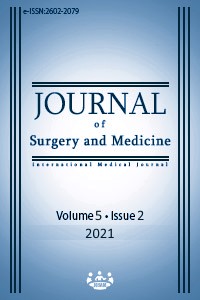Antibiotic consumption in the hospital during COVID-19 pandemic, distribution of bacterial agents and antimicrobial resistance: A single-center study
Keywords:
COVID-19, culture, infection, antibiotic-resistance, bacteriaAbstract
Background/Aim: In recent years, the consumption of broad-spectrum antibiotics used in hospitals and the number of multidrug-resistant pathogens are increasing. Coronavirus disease 2019 (COVID-19) pandemic could also affect consumption of antibiotics used in the treatment of hospital-acquired infections and cause a difference antibiotic resistance rate. There is no study on whether there was a change in this trend during the COVID-19 pandemic in Turkey. Our study was conducted to determine antibiotic consumption, the distribution of bacterial agents in culture samples and changes in their antimicrobial resistance rates in our hospital during the COVID-19 pandemic. Methods: In this retrospective cohort study, January and February 2020 were defined as the pre-pandemic period (PPP), and March and April, as the pandemic period (PP). The bacterial agents isolated from blood, urine, and respiratory samples and the rates of antibiotic consumption during these periods were compared using statistical methods. Results: A total of 3,384 samples were analyzed during the PPP and 2,170 samples, during the PP. While the total bacterial agents isolated in PPP was 469, this number was 394 in PP. The isolation of Escherichia coli, Acinetobacter baumannii complex was significantly lower in the PP (P<0.001; P=0.008, respectively). Conversely, the isolation of Enterococcus spp. was higher during the PP (P<0.001). In the PP, the consumption of piperacillin-tazobactam, teicoplanin, meropenem and fluoroquinolones (ciprofloxacin, levofloxacin, and moxifloxacin) were significantly higher (P<0.001; P=0.016; P=0.016; P=0.02; P<0.001; P=0.018, respectively) while that of cefazolin was significantly lower (P<0.001). Total antibiotic consumptions during the PPP and PP were 725.8 DDD / 1000 and 811.4 DDD / 1000 inpatient days, respectively (P=0.002). Conclusions: Although bacterial agents isolated in PP were lower, antibiotics consumption was higher. The high positivity rate of Enterococcus spp. during the PP suggests that hand hygiene and contact isolation should be strictly observed, as this may be related to the inadequacy of hygiene practices.
Downloads
References
Klein EY, Van Boeckel TP, Martinez EM, Pant S, Gandra S, Levin SA, et al. Global increase and geographic convergence in antibiotic consumption between 2000 and 2015. Proc Natl Acad Sci U S A. 2018;115(15):E3463-70.
Isler B, Keske Ş, Aksoy M, Azap ÖK, Yılmaz M, Yavuz SŞ, et al. Antibiotic overconsumption and resistance in Turkey. Clin Microbiol Infect. 2019;25(6):651-3.
Soyletir G, Altinkanat G, Gur D, Altun B, Tunger A, Aydemir S, et al. Results from the Survey of Antibiotic Resistance (SOAR) 2011-13 in Turkey. J Antimicrob Chemother. 2016;71 Suppl 1(Suppl 1):i71-83.
Zengin S, Avcı S, Yılmaz S. Clinical and basic cardiovascular features of patients with COVID-19 admitted to a tertiary care center in Turkey. J Surg Med. 2020;4(5):367-70.
Roth A, Wiklund AE, Pålsson AS, Melandar EZ, Wullt M, Cronqvist, et al. Reducing blood culture contamination by a simple informational intervention. J Clin Microbiol. 2010;48(12):4552-8.
Linsenmeyer K, Gupta K, Strymish JM, Dhanani M, Brecher SM, Breu AC. Culture if spikes? Indications and yield of blood cultures in hospitalized medical patients. J Hosp Med. 2016;11(5):336-40.
Shapiro NI, Wolfe RE, Wright SB, Moore R, Bates DW. Who needs a blood culture? A prospectively derived and validated prediction rule. J Emerg Med. 2008;35(3):255-64.
Antunes LC, Visca P, Towner KJ. Acinetobacter baumannii: evolution of a global pathogen. Pathog Dis. 2014;71(3):292-301.
Dijkshoorn L, Nemec A, Seifert H. An increasing threat in hospitals: multidrug-resistant Acinetobacter baumannii. Nat Rev Microbiol. 2007;5(12):939-51.
Boral B, Unaldi Ö, Ergin A, Durmaz R, Eser ÖK; Acinetobacter Study Group. A prospective multicenter study on the evaluation of antimicrobial resistance and molecular epidemiology of multidrug-resistant Acinetobacter baumannii infections in intensive care units with clinical and environmental features. Ann Clin Microbiol Antimicrob. 2019;18(1):19.
Kilbas I, Ciftci IH. Antimicrobial resistance of Enterococcus isolates in Turkey: A meta-analysis of current studies. J Glob Antimicrob Resist. 2018;12:26-30.
Remschmidt C, Schröder C, Behnke M, Gastmeier P, Geffers C, Kramer TS. Continuous increase of vancomycin resistance in enterococci causing nosocomial infections in Germany - 10 years of surveillance. Antimicrob Resist Infect Control. 2018;7:54.
Barros M, Martinelli R, Rocha H. Enterococcal urinary tract infections in a university hospital: clinical studies. Braz J Infect Dis. 2009;13(4):294-6.
Siegel JD, Rhinehart E, Jackson M, Chiarello L; Health Care Infection Control Practices Advisory Committee. 2007 Guideline for Isolation Precautions: Preventing Transmission of Infectious Agents in Health Care Settings. Am J Infect Control. 2007;35(10 Suppl 2):65-164.
Climo MW, Yokoe DS, Warren DK, Perl TM, Bolon M, Herwaldt LA, et al. Effect of daily chlorhexidine bathing on hospital-acquired infection. N Engl J Med 2013;368(6):533-42.
Guclu E, Ogutlu A, Karabay O, Demirdal T, Erayman I, Hosoglu S, et al. Antibiotic consumption in Turkish hospitals; a multi-centre point prevalence study. J Chemother. 2017;29(1):19-24.
Plüss-Suard C, Pannatier A, Kronenberg A, Mühlemann K, Zanetti G. Hospital antibiotic consumption in Switzerland: comparison of a multicultural country with Europe. J Hosp Infect. 2011;79(2):166-71.
Cunha BA. The atypical pneumonias: clinical diagnosis and importance. Clin Microbiol Infect. 2006;12 Suppl 3:12-24.
Olesen SW, Barnett ML, MacFadden DR, Brownstein JS, Diaz S, Lipstich M, et al. The distribution of antibiotic use and its association with antibiotic resistance. Elife. 2018;7:e39435.
Harbarth S, Samore MH. Antimicrobial resistance determinants and future control. Emerg Infect Dis. 2005;11(6):794-801.
Downloads
- 1030 1190
Published
Issue
Section
How to Cite
License
Copyright (c) 2021 Aziz Ahmad Hamidi, Şerife Yılmaz
This work is licensed under a Creative Commons Attribution-NonCommercial-NoDerivatives 4.0 International License.
















